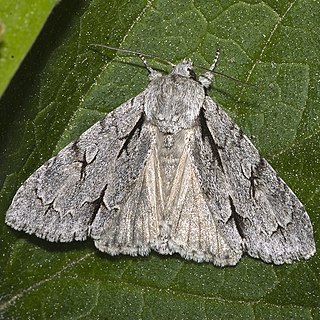
Acronicta is a genus of noctuid moths containing about 150 species distributed mainly in the temperate Holarctic, with some in adjacent subtropical regions. The genus was erected by Carl Linnaeus in his 1758 10th edition of Systema Naturae. Caterpillars of most Acronicta species are unmistakable, with brightly colored hairy spikes, and often feed quite visibly on common foliate trees. The hairy spikes may contain poison, which cause itchy, painful, swollen rash in humans on contact. The larva of the smeared dagger moth is unusually hairy even for this genus. Acronicta species are generally known as dagger moths, as most have one or more black dagger-shaped markings on their forewing uppersides. But some species have a conspicuous dark ring marking instead.

Pygaerinae is a subfamily of the moth family Notodontidae, the silver prominents and relatives. The genus list is preliminary, as not all Notodontidae have been assigned to subfamilies yet.
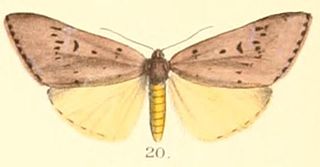
Adrepsa is a genus of moths in the subfamily Arctiinae first described by Frederic Moore in 1879.

Barsine is a genus of moths in the family Erebidae.
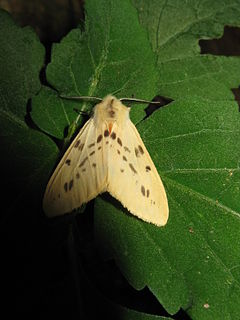
Lemyra is a genus of tiger moths in the family Erebidae. The genus contains many species from East and South Asia, Sundaland and Australia. It was described by Francis Walker in 1856.

Lymantria is a genus of tussock moths in the family Erebidae. They are widely distributed throughout Europe, Japan, India, Sri Lanka, Myanmar, Java, and Celebes. The genus was erected by Jacob Hübner in 1819.
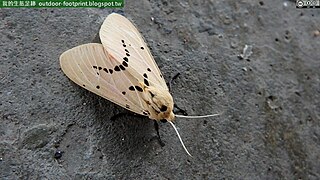
Spilarctia is a genus of moths in the family Erebidae. The genus was erected by Arthur Gardiner Butler in 1875.

Coarica is a monotypic moth genus of the family Noctuidae. Its only species, Coarica fasciata, is known from India, Thailand and China. Both the genus and species were first described by Frederic Moore in 1882.

Itmaharela is a genus of moths of the family Noctuidae.

Pimprana is a monotypic moth genus of the family Noctuidae. Its only species, Pimprana atkinsoni, is found in Darjeeling, India. Both the genus and species were first described by Frederic Moore in 1879.
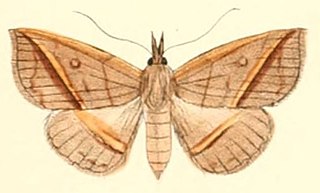
Talapoptera is a monotypic moth genus of the family Erebidae erected by George Hampson in 1926.
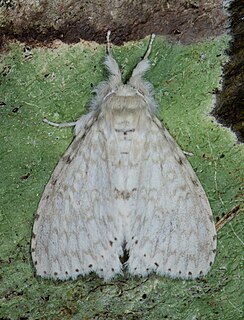
Dura is a genus of tussock moths in the family Erebidae. The genus was erected by Frederic Moore in 1879.
Himala is a genus of moths in the subfamily Lymantriinae. The genus was erected by Moore in 1879.

Imaus is a genus of tussock moths in the family Erebidae. The genus was erected by Frederic Moore in 1879.

Baorisa hieroglyphica is a species of moth in the family Erebidae. It was described by the British entomologist Frederic Moore in 1882. The genus Baorisa was long thought to be monotypic, but three other species have been described. It is found in parts of northeastern India and Southeast Asia.
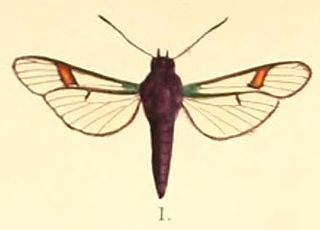
Pramila is a monotypic genus of moth in the family Sesiidae. Its only species, Pramila atkinsoni, occurs in the Bengal region of what was British India. Both the genus and species were first described by Frederic Moore in 1879.

Ginshachia gemmifera is a moth of the family Notodontidae. It is found in India.
Chatra is a genus of moths in the family Lasiocampidae. The genus was erected by Frederic Moore in 1879.
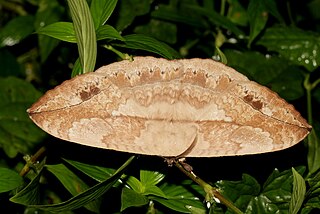
Eupterote is a genus of moths in the family Eupterotidae. It was first described by Jacob Hübner in 1820.

















